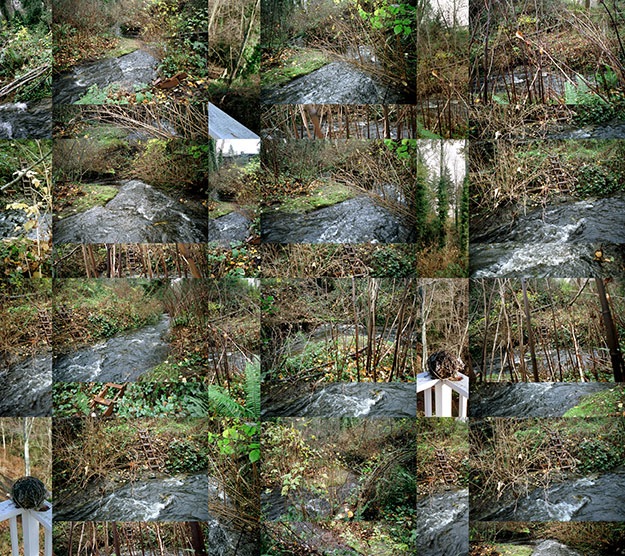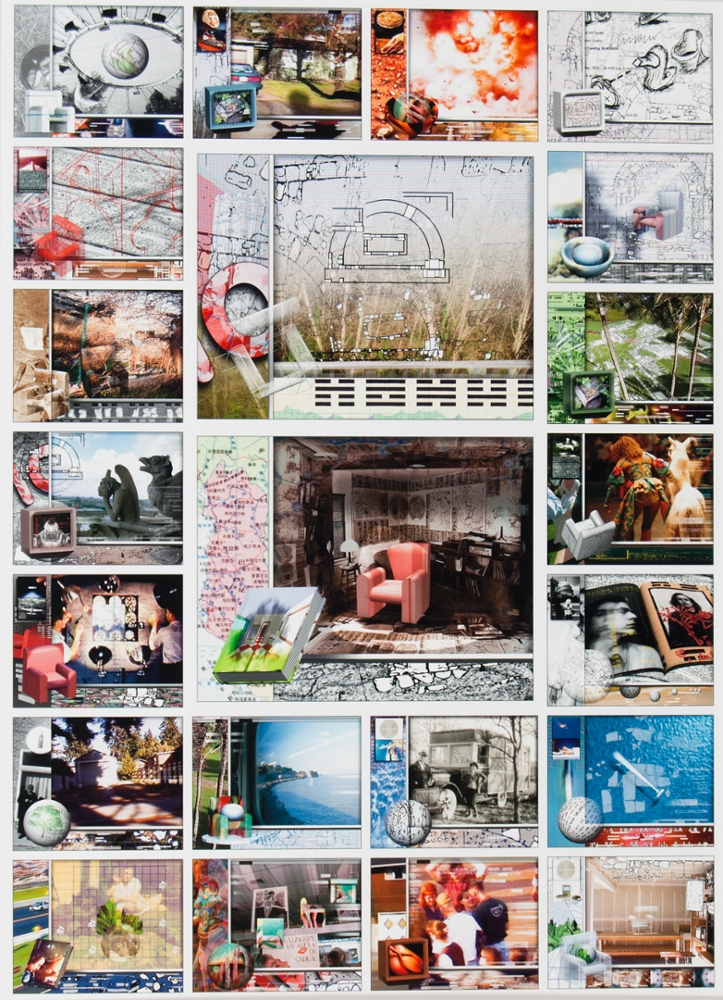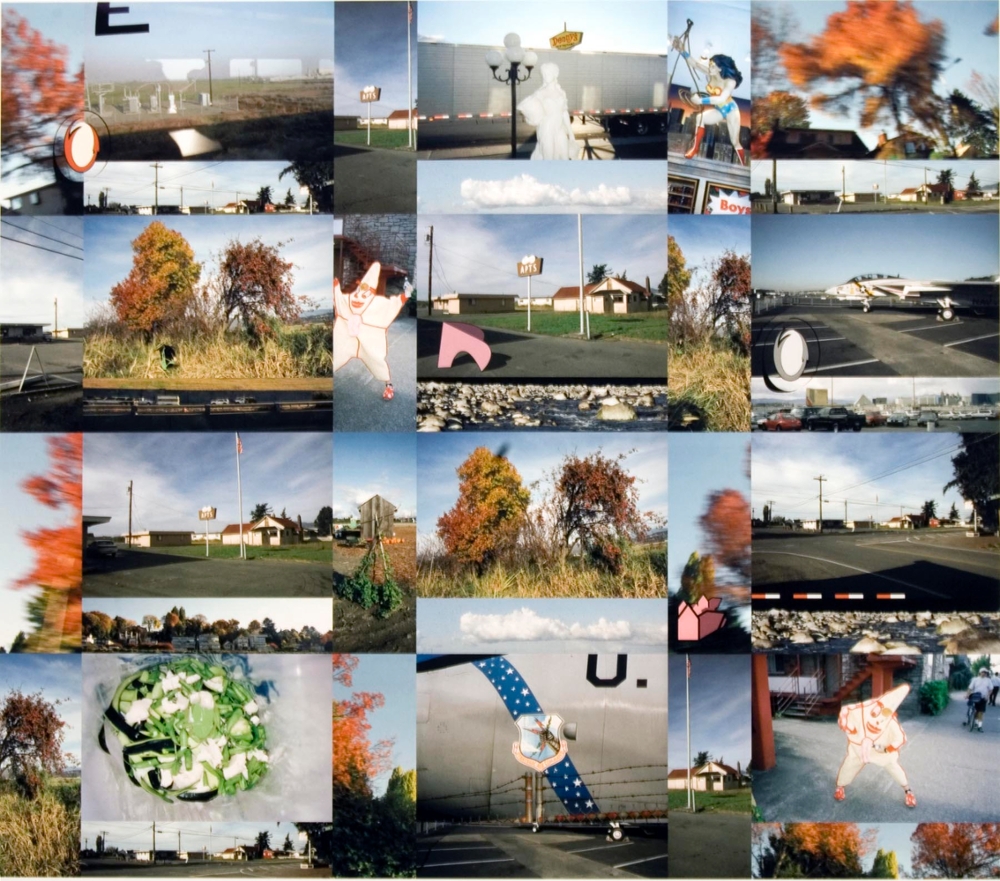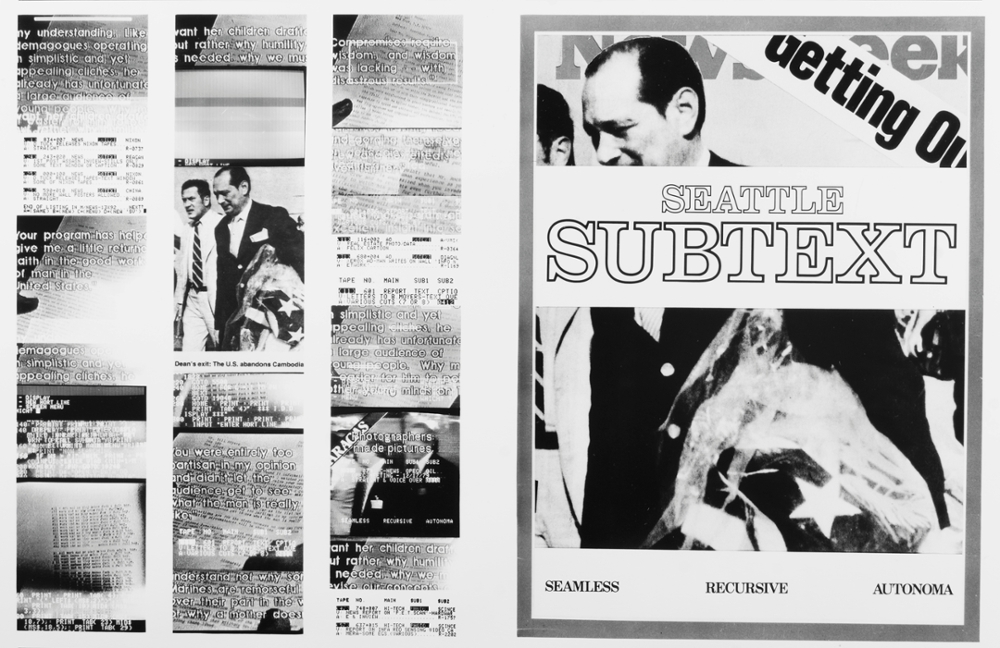Beyond Digital Novelty: Paul Berger 1972-2003
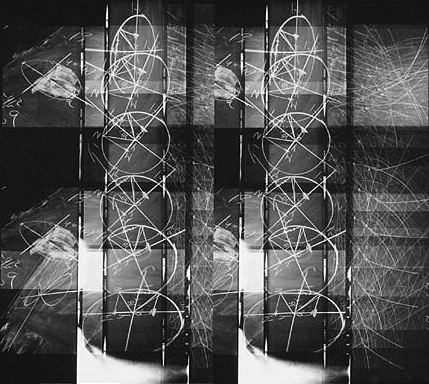
About the Exhibition
Beyond Digital Novelty: Paul Berger 1972-2003
After nearly twenty years of exponentially widening availability of digital-imaging technologies, fueled by thousands of university computer art courses, it is interesting that the technology, in the hands of serious artists, has so quickly become transparent. Those who have incorporated its possibilities in compelling and imaginative ways have generally continued the explorations of appropriation and collage begun in the first third of the twentieth century by artists such as Paul Citröen, John Heartfield, Hannah Hoch, László Moholy-Nagy, and Kurt Schwitters. Aesthetic breakthroughs and poetic invention, as usual, occur in slow, steady steps, much more related to world events like war and economic depression than to improvements in the technology or process of picture-making.
When digital technologies hit the photographic world, a very high percentage of artists who use photography were confined within the daily routine of teaching in universities. Because they could not easily get away, they had to find more interesting ways to photograph instead of more interesting things to photograph. What appeared at first to be a limitation ultimately resulted in an exponentially expanded field of photographic practice. There was a renewed interest in mass media as subject, and, perhaps related to this, autobiographical modes based on a new self-consciousness about being a visual artist in a world blanketed by imagery.
Paralleling this turning of photography back on itself in academia was the postmodern critique of art and culture begun in the mid-1970s. Simply stated, this critical position encouraged artists to carry their imaging into the secondary “forest of signs” of our mediated world, rather than into the primary experience of the forests of Yosemite. Because digital technologies had been in use by the media, the military, and advertising long before artists gained access to them, they were appealing to artists responding to the new critical theories. What better way to examine the human consequences of mediated culture than with the tools that make it possible?
This exhibition celebrates the achievements of Paul Berger, who first included a computer in the production of his art in the early 1980s. His decision was based in part on the metaphoric possibilities of its characteristics-the capacity to sort on key words (like the mind), to recombine information in order to achieve different conclusions (like memory), to present a “face” that intricately hid its motivations, and so on. As a student in California and New York, Berger had begun his career more than a decade earlier, however, with an exploration of how and what we learn from the photographic image, specifically the image combined with text. This present survey of his work from 1973 to 2003 tracks his methodical progress before and after the digital divide, driven by a finite number of structural and conceptual concerns. Berger’s career reveals his concentrated dedication and clarity of purpose: how do we know what we know in a maelstrom of images specifically designed to confuse us and rob us of access to our own experience, opinions, and knowledge? How do we test the difference between information and knowledge when replication in the form of imagery is increasingly substituted for experience? How do we get behind the “face” of our experience?
The predigital 1976 Mathematics series is the locus of four important long-term concerns for Berger. The first he calls “the site of notation,” the point at which ideas become graphic. By accident he found a room full of blackboards with mathematics formulae at the University of Illinois where he taught in 1976 – 77. Initially he was drawn to the formal beauty of the white chalk on the black field and the way that black and white film recorded the formulae as free floating in a black space. As is his habit, however, Berger immersed himself in the project and met some of the mathematics faculty. He found that these (to him) incomprehensible marks represented the edge of an exploration into the nature of knowledge that was very similar to art in the sense that their gestural formal beauty derived to a certain degree from the raw excitement of the frontier of knowledge they recorded. This space-where the hand makes the mark, where thought becomes image-became and remains a central concern in Berger’s art. In a peculiar way, it is a pure space where communication is abstractly symbolic and concretely calligraphic at the same time.
Another of his concerns is the mechanics of narrative, especially an articulated sequence of imagery. Berger is not so much interested in telling stories as he is with figuring out how the sequential narrative, as a conventional device, gets the story told. To keep this inquiry honest, Berger generally has mined structured elements of his childhood that many can share and all can understand: baseball cards, comic strips, television news and sports. Cartoons, as a condensed, purified form of narrative, create a story with a minimum of clues in an arena of maximum illusion and multiple viewpoints. Berger began with the form of these simple, closed arenas as models for a larger concern with how we, as he says, “figure” photographs, as the ultimately confusing graphic representation of experience. He has refused to forget, or ignore, that photographs that simplistically appear to be factual statements are really just flat, frame-bound, closed arenas of evidence that do not admit to anything without the introduction of a human eye, without human experience to support their abstract claims.
This interest in closed arenas is evident in the large 1979 Camera Text or Picture series, which uses a two-page spread, comic-strip structure with internal frames that often break loose to float and overlap. Between the strips is a gray grid that isolates them with Platonic formal simplicity. The imagery in this project is drawn from televised sports events played within defined spaces or arenas that provide another set of internal frames. In addition to being enclosures for narrative, frames have become a metaphor in Berger’s work for the importance of understanding context-both literal and figurative frames of reference-in media and popular culture. Ideally, we know who we are by the response of those around us. We are framed by human contact and interaction. In media space, as Marshal McLuhan noted in the 1960s, we are defined by our response to a model of designed human responses to which we have no real communication access.
Another ongoing element of Berger’s art, found in the Mathematics series, is the notion of “the automaton,” his word for the relinquishing of part of the creative responsibility to his equipment and materials. In this case he was using a camera with an unpredictable film advance that in both a real and figurative sense forced him to break out of the conventional photographic frame. His first uses of the computer, and subsequent use of early frame grabbers and digital cameras for the 1984 Print Out project, would necessarily involve the acceptance of productive error.
Berger’s exploration of this extended notion of narrative continued in the 1981 Seattle Subtext project, which resulted in a Real Comet Press book in 1984. Using the template of the layout divisions in news magazines such as Time and Newsweek, he constructed his own alternative narrative. As raw material for his version of the news, he used images from video and television, his own photography, and some family snapshots. Instead of text he used printouts of a database he devised to catalogue his collection of VCR tapes copied from network television. This complex and dense work braids various lyrical sequences of images and words into a reflexive narrative-each providing metaphors for the others, but certainly never resolved in the convention of the single-source editorial voice of the news magazine. Occasionally the standard magazine divisions are ironically subverted. The “World” section, for example, consists entirely of a visual inquiry into his family’s world just before he was born, again juxtaposed with his relational database filing system. The snapshots of the pre-Paul family are, in a sense, a database for discovering Paul.
An interest in cards of all kinds-playing decks, the Tarot, baseball cards-and the fact that they define in their various uses a closed system while allowing for a tremendous variety of combinations-led Berger to explore new notions of narrative. He became intrigued with the idea that visual and conceptual connections between arrays of images can work both in union and at cross purposes, resulting in interesting internal conflicts. In addition, sometimes the graphic connections can be causal and generative and sometimes relational and transformational. In the first instance, groups of images work in unison to produce a cumulative meaning beyond themselves-they generate a whole greater than their sum. In the second situation, different combinations of a series of discrete images can produce entirely different net effects, and imply missing information between them.
In his 1988 Cards series, a set of large ink jet color prints, Berger employed a finite number of iconic images pulled for the most part from television, but in some cases from his own photographs. These cards are clear and modular in their design but cryptic in the connections between them, even though they are built from entirely accessible and familiar elements. At this point Berger began to consolidate his thinking about human and computer memory being similar insofar as they are random in their process but not haphazard in their selections. Like the vaguely repetitive connections between the imagery in these cards, elements of memory can be unreasonable or even bizarre, but they always have the potential of interpreting experience in useful ways. Real card games feed the players information in recombinant units and depend on their ability to distinguish between memory and imagination. Berger uses that model to help reestablish our ability to distinguish between seeing and photography in an image-saturated world.
In a subsequent project, the 1992 World Info series, Berger continued his exploration of the effects of both scientific and graphic models on cognition, specifically on our ability to think for ourselves without models. Weather maps with their familiar symbols and graphics are a good example of a model and serve in many of Berger’s projects as a central metaphor for how trust and confidence can be confused with, or substituted for, understanding. The spaces between models, however, allow diverse and alternative explanations to fall through. The “meteorologists” in business suits laying hands on an image of the world always appears smooth and controlled even though the reality they describe usually is chaotic and totally unpredictable. What they profess as special knowledge can often be much more easily understood by simply looking out the window. Most of the images in this series are grounded on a fine blue graph paper grid, the matrix of scientific modeling before the computer’s ones and zeros. This underpinning is an echo of Berger’s earlier use in Print Out of columns of computer code beneath images representing media news and science models.
The recurring image in Berger’s work of the late 1980s and 1990s of a tragically exploding Challenger space shuttle, in the same resolution and format as the cheerfully self-confident pseudo-scientific T.V. talking head, exemplifies events not reported in terms of their human consequences. This event and its “coverage” are both a shocking failure of the scientific models of what we can know and of the media models of what we need to know. The “news,” for example, is only of real interest to those to whom nothing has happened. The experience of those in the shuttle at that moment was, to them, neither describable nor explicable.
The 1998 – 99 Card Plates series of fourteen large Iris prints, in Berger’s own words, “begins with the metaphor of the uncut press sheet, raw off the printing press. Each print has the dauntingly dense and composite look of a pre-cut press sheet. Each weaves a repetition and redundancy across a quasi-narrative space: a cross between mosaic and comic strip. However, there is a basic card unit sub-structure to this image-wall, and their sub-units are as much alike as they are distinct-like playing or collector cards. The format in each card (there are 274 in total) is composed of three picture spaces: one to the upper right which is larger and of photographic aspect ratio, one to the left which is a thin vertical, and one on the bottom which is a long horizontal. At the juncture of all three is a simple 3D object, like a board game token-a chair, a sphere, a book, a bowl, or a television. The length and structure of the deck is only implied, as each sheet is uncut. It might be endless or partial; it might be complete but simply scrambled or shuffled. It might be intended for a game which can never be won or lost.”
The reference to weaving in this statement bridges to the two most recent projects, Warp and Weft: Figure, and Warp and Weft: Ground, completed in 2003. These two groups of seven very large Iris prints are a continuation of the pattern used in Card Plates, but with larger, fewer, and less dense units. The concepts of point of notation, the narrative sequence, the automaton, and the closed arena are all still present. The metaphor of weaving in the Warp and Weft series occurred to Berger when he was thinking about a rug in his childhood home that contained a representation of an animal that stood out clearly in the standard illusion of figure and ground. The back of the rug, however, where the illusion was created and sustained, was messy and not clear at all. So there were two layers of encryption, first in the conventional model of depth in a flat field, and second in the more mysterious code known only to the weaver, working backwards with colors and patterns reversed. This is another metaphor for what Berger has been exploring all along, seen earlier in the discussion of the mathematicians and in the digital underpinnings of the communication industry and its various media. We are seldom encouraged to turn over the rug to understand that what generates what we see is often messy and ambiguous.
The subjects of the two series are two aspects of Berger’s daily life in Seattle and mark a return to the honesty of subject in his earlier work. Warp and Weft: Ground is derived from photographs of a deep ravine in his back yard that meanders according to gravity, generally wild and ignored beneath and through the superimposed grid of the neighborhoods. Warp and Weft: Figure observes the human life that occupies that grid. As in his previous work, what the camera cuts into and through are layers of cycle and repetition, seasonal invasions and loss-metaphors for the unstoppable weather patterns of perception and memory that have to be contained within categories and models for us to be able to proceed. But also, the Figure series is the equivalent of the front side of the family rug and the Ground the back side-both series were created concurrently. Berger, in this project, continues his overall project of trying to understand what the back side of the photograph looks like-what we need to know to qualify and accept the front, the face.
While Berger knows more and more about the computer’s possibilities, he is still willing to let it off his leash, to let it make a few decisions for him, as he did with the faulty camera he used for the Mathematics series. There is an even more revealing continuity of his method, ranging from his sorting of film contact strips to create Mathematics in 1976 and his physically laying out of small color prints to determine the form of the 2002 – 2003 Warp and Weft series. This persistent pursuit may have something to do with his father’s being a tile setter, and it may also stem from a need to keep his own real hands on the controls of a graphic arena that can quickly become seamless, faceless, and inescapable.
—Rod Slemmons
Image Gallery

